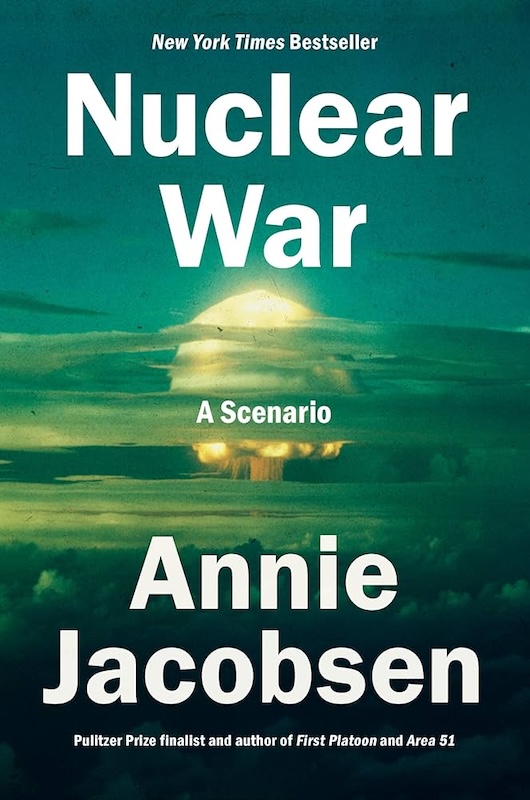Nuclear Devastation
A review of Annie Jacobsen’s Nuclear War: A Scenario

Nuclear War
A Scenario
by Annie Jacobsen
Penguin Publishing Group, 2024

Annie Jacobsen’s 2024 book, Nuclear War: A Scenario is a page-turner–in a horrific way. Jacobsen opens the book with a disconcertingly detailed description of what would happen if a one-megaton thermonuclear bomb were to explode over Washington, D.C. Jacobsen notes that in this scenario, the entire U.S. government and a host of government-related institutions would be utterly destroyed, along with millions of people unfortunate enough to be living anywhere near D.C. According to Jacobsen, this kind of assault, called a “decapitation strike” in the military’s colorful parlance, would cause even more widespread devastation if a nuclear device were to explode at a nuclear power plant such as Diablo Valley in California. The radioactive fallout would be horrific since it would include the vast amount of radioactive spent fuel rods stored in this location.
The book describes the near-impossibility of stopping intercontinental ballistic missiles (ICBMs) and the total impossibility of stopping submarine-launched ballistic missiles (SLBMs), which can attack from undetectable locations just offshore. Jacobsen also discusses the hair-trigger alerts in place in the U.S. and the handful of minutes that the President (or whoever was still alive in the line of succession) would have to decide on the target and nature of a counterattack. The book notes the near-certainty that other nuclear powers would also launch missiles in this scenario because they also have hair-trigger alerts and would have no time to distinguish a direct attack from an attack on a neighboring country. Since nuclear weapons launch sites are themselves prime targets, the doctrine of “use ’em or lose ’em” comes into play. The cascading consequences would be uncontrollable. The book includes a discussion of the consequences of nuclear winter, which is the icing on the apocalyptic cake (no pun intended).
Nuclear War: A Scenario is a well-documented book, which draws on the work of many scientists, including The Cold and the Dark: The World After Nuclear War, by Paul Ehrlich, Carl Sagan, and others, published in 1984. The text is a record of conference proceedings from the Long-Term Worldwide Biological Consequences of Nuclear War held in Washington, D.C. in 1983, which involved over 200 scientists engaged in an exploration of “nuclear winter–a much more profound and long-lasting devastation of the earth and atmosphere than had been believed possible before.” The Erlich-Sagan book is 40 years old, but the laws of physics and the fragility of biological organisms (which includes us) are pretty much the same as in 1984. What has changed is that there are more thermonuclear weapons, more and better delivery systems (those marvels of engineering–the ICBMs and SLBMs), and thanks to proliferation, more countries that have them.
After reading Jacobsen’s Nuclear War: A Scenario and thinking about the contributions of Ehrlich et al., the only way I could sleep at night was to imagine it all as a work of science fiction. But it’s not.
Featured Image credit: arhangel; modified by Tempest.
Opinions expressed in signed articles do not necessarily represent the views of the editors or the Tempest Collective. For more information, see “About Tempest Collective.”
We want to hear what you think. Contact us at editors@tempestmag.org.
David Friedman View All
David Friedman has been a socialist for seventy years. He was a member of the Berkeley Independent Socialist Club in the 1960s and beginning in 1963 active in the Civil Rights Movement, the Berkeley Free Speech Movement, the struggle against the Vietnam War, and the teacher’s union.
